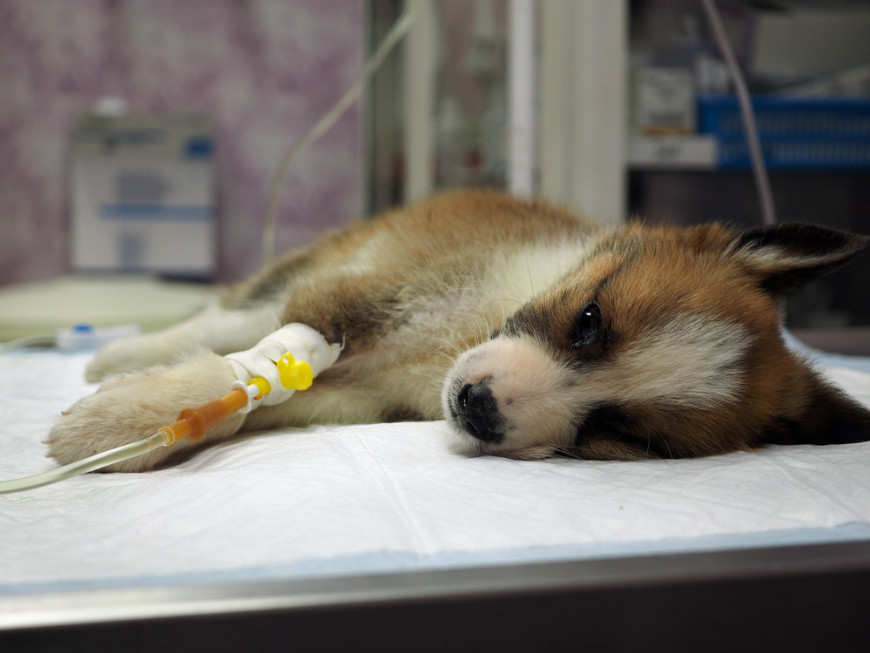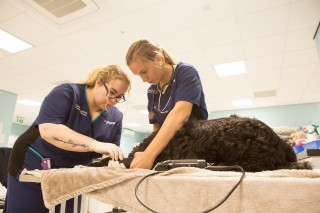Do you need help?

What is canine parvovirus?
Parvovirus enteritis (PVE) is a highly contagious disease caused by the canine parvovirus, or parvo as it’s commonly known. The virus is very tough and can survive at room temperature for up to two months and potentially years in a moist environment without sunlight.
The virus attacks the gastrointestinal tract, and immune system of puppies and dogs. It can also damage the heart muscle in young puppies and unborn puppies.
How do dogs and puppies become infected with parvovirus?
Parvo is typically spread through direct contact with an infected dog or indirect contact with something contaminated. Large concentrations of the virus are found in an infected dog’s faeces, so if your dog sniffs these, even if the bulk has been responsibly cleared up, they may become infected.
The virus particles can also be spread on contaminated hands, shoes, clothing, pet bowls and accessories.
What are the symptoms of parvovirus infection?
Parvo symptoms generally develop within five to seven days of infection, although this period has been known to range from two to 14 days. Early symptoms of parvovirus typically include lack of appetite, extreme tiredness and fever, followed by sickness and diarrhoea 24 to 48 hours later.
Dogs with parvo quickly become dehydrated and weak. You may notice your dog’s gums becoming darker (dark pink/red) or paler than normal.
In severe cases, dogs are also likely to have
- A weak pulse,
- A racing heart rate and
- Show signs of hypothermia (low body temperature)
Contact your vet immediately if your puppy or dog shows any of these signs.
At-risk dogs: who’s most vulnerable?
Puppies under six months old, unvaccinated puppies, and unvaccinated dogs are most likely to catch parvo.
Meanwhile, certain breeds of domestic dogs, including American Pit Bull Terriers, Doberman Pinschers, English Springer Spaniels, German Shepherds and Rottweilers, are at increased risk. Among adult dogs, males are more likely than females to contract parvo.
Vaccination is the only effective way to reduce your dog’s risk of contracting parvovirus but no vaccine is 100% effective. In very rare cases, dogs who are up to date with their vaccinations may still contract the disease.
Preventing parvovirus: vaccinations
Parvovirus can survive in soil for more than a year and may theoretically be spread through the environment by foxes. Vaccination is the only effective way to prevent your dog from contracting parvovirus if they come into contact with the virus.
Immunity is not lifelong, though. After an initial vaccination course of two or three vaccinations, regular booster vaccinations are required throughout life. Your dog’s annual vaccination will include a component against parvo, and it’s important to maintain up-to-date vaccinations as your dog gets older. Puppies can be vaccinated from six weeks of age.
Preventing parvovirus: hygiene practices
Good hygiene is also vital to preventing canine parvovirus from spreading.
If you suspect your environment has been contaminated with faeces or vomit from a parvo-infected dog, you should:
- Wash the affected area with a household bleach solution
- Soiled bedding should be discarded
- All kennels, collars, bowls and leads should be appropriately cleaned and sterilised
Infected dogs should be kept away from healthy dogs until they have recovered fully.
What if I come into contact with an infected dog?
If you have come into contact with an infected dog yourself, you should ensure any contaminated clothing is removed (destroyed or carefully cleaned), and that you carefully wash your skin with a suitable parvocidal skin cleanser before handling other dogs.

Parvovirus treatment in dogs
There's no specific drug to treat parvovirus in dogs, but those affected by the infectious disease may have a far greater chance of survival if they receive early, aggressive treatment and intensive nursing care.
Treatment may include:
- Intravenous fluids (a drip) to treat shock and correct dehydration and electrolyte abnormalities
- Anti-sickness medication
- Tube feeding
- Painkillers
- Plasma transfusions and/or blood transfusions to replace proteins and cells
- Antibiotics to treat or prevent secondary infections as a result of the effects of parvovirus infection
Understanding the survival rate of canine parvovirus infection
Awareness and proactive prevention are your best defences against Canine Parvovirus.
We can safeguard dogs and puppies from this formidable disease through informed vigilance, intensive treatment, and responsible pet care.

Prince's story highlights dangers of parvovirus
A pet owner whose puppy was diagnosed with canine parvovirus has warned of the dangers of the disease. Cherelles had a chihuahua, Prince, for just a day when he began vomiting and suffering diarrhoea.
She recognised the symptoms of canine parvovirus, so she rushed him to Vets Now in Barton-Le-Clay. Cherelles said: “The test came back positive. Thankfully, Prince came through it thanks to the excellent care he received.”
Preventing infected dogs through awareness
Awareness and proactive prevention are your best defences against Canine Parvovirus.
Through informed vigilance, intensive treatment, and responsible pet care, we can safeguard dogs and puppies from this formidable disease.

